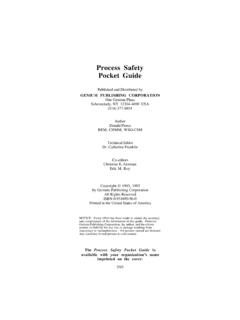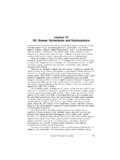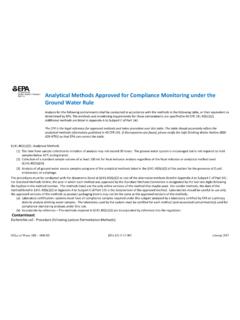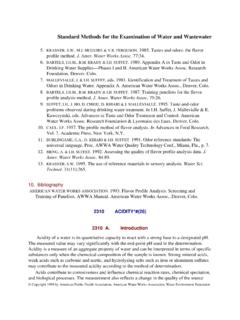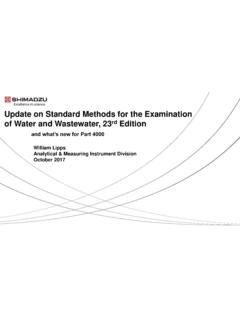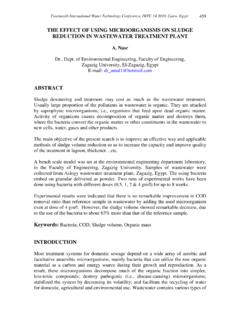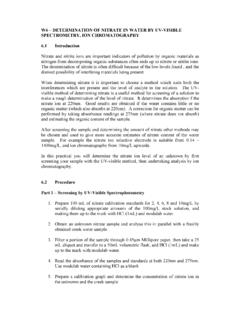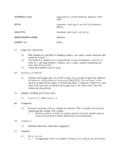Transcription of GUIDE TO ENVIRONMENTAL ANALYTICAL METHODS 5th …
1 GUIDE TOENVIRONMENTALANALYTICALMETHODS5th EditionEdited byRoy-Keith Smith, PhDApichemical ConsultantsGenium Publishing Corporation1171 RiverFront Center, Amsterdam, NY 12010 (518) PUBLISHING CORPORATIONG uide to ENVIRONMENTAL ANALYTICAL MethodsTable of Contents Pa g e IntroductioniiiAnalytical METHODS Organic Constituents1 Herbicides (chlorinated) by GCMethod Comparison3 Analyte Listing8 Pesticides (organochlorine) and PCBs by GCMethod Comparison9 Analyte Listing18 Semivolatile Organic Compounds by GC/MSMethod Comparison20 Analyte Listing28 Volatile Organic Compounds by GC/MSMethod Comparison37 Analyte Listing46 Volatile Organic Compounds by GCMethod Comparison50 Analyte Listing58 ANALYTICAL METHODS Inorganic Constituents61 Cyanide (total and amenable)Method Comparison62 Organic Carbon (total)Method Comparison69 Mercury by Cold Vapor Atomic Absorption Method Comparison71 Trace Metals by Flame & Graphite FurnaceAtomic Absorption SpectroscopyMethod Comparison76 Analyte Listing80 Trace Metals by ICP-AESM ethod Comparison82 Analyte Listing87 Trace Metals by ICP-MSMethod Comparison88 Analyte Listing94 ANALYTICAL METHODS Anions9 5 Multi-Analyte Analysis of AnionsMethod Comparison95 Analyte Listing97 Sampling Procedures and Preparation9 9 Method Reference and Sampling GuidelinesSolid and Aqueous100 Drinking Water122 Sampling Extraction METHODS (solids)SW-846124 Sampling Extraction METHODS (liquids)SW-846128 Sampling Cleanup MethodsSW-846130 Sampling Extraction and Cleanup MethodsStandard METHODS , 20th Edition 134 EPA 500 Series136 CFR 40138 CLP140 Elemental Analysis141 APPENDICESA.
2 Tables Extracted from Original DocumentationEPA Contract Laboratory Program (CLP) - Organic Statement of WorkA-1 EPA Contract Laboratory Program (CLP) - Inorganic Statement of WorkA-18 EPA 200 SeriesA-22 EPA 500 SeriesA-31 EPA 600 SeriesA-74 GENIUM PUBLISHING CORPORATIONG uide to ENVIRONMENTAL ANALYTICAL MethodsTable of Contents, continued Pa g e APPENDICESS tandard METHODS for the examination of water and wastewater , 20th EditionA-90SW-846, EPA Test METHODS for Evaluating Solid WasteA-114B . Organic Analyte Cross-Reference to MethodsB-1C . Inorganic Analyte Cross-Reference to MethodsC-1D. SW-846 HistoryD-1E. Terms and AbbreviationsE-1F. ReferencesF-1 GENIUM PUBLISHING CORPORATIONiiiINTRODUCTION TO 5th EDITIONThe fifth edition of the GUIDE to ENVIRONMENTAL ANALYTICAL METHODS covers the massivechanges that have continued to take place to EPA METHODS , affecting organic andinorganic determinative METHODS along with preparative and sampling the last edition of The GUIDE , EPA SW846 has been updated with many newmethods; existing METHODS have been revised; and more METHODS removed.
3 Forinstance the large number of individual flame AA and graphite furnace AA methodsfor metals have been collapsed into general METHODS 7000B and 7010, IV to SW-846 has been out in distribution for several years however the legalstatus of the update is uncertain in many States as the Office of Solid Waste has notpromulgated the update, choosing instead to hold fast to the idea of SW-846 asguidance rather than regulation. I have chosen to update this book to Update IV ofthe Third Edition of SW-846 as many laboratories are already using it. Previouseditions of this book present appropriate information about earlier SW-846 changes from SW846 Final Update III are so expansive that the Method StatusTable in Appendix D of this fifth edition has been revised, listing current promulgatedmethods and available more recently revised CLP data are extensively revised to reflect the newest Statements of Work:inorganics , December, 2001, and organics , May, 1999 , December, 2000.
4 Further, tabular data on the CLP organics have beenexpanded to include the low concentration method in a side-by-side comparison withthe multi-media, multi-concentration Statement of Work. The inorganic SOW isnoteworthy as no FLAA nor GFAA techniques are included in it and the dreadedGFAA decision flowchart has been important addition to the fifth edition is tabular comparison of multi-anion analysisby ion chromatography and capillary electrophoresis. These ANALYTICAL techniques arebecoming more visible within the industry and the regulatory framework. Theincreased number of practitioners of these METHODS justifies their discussion and data relating to the analysis of PCB congenors in SW-846 Method8082A has been deleted, as it is an inadequate method for the stated objective. TheOffice of water is working on Method 1668, which is a high resolution massspectrometer technique capable of identifying and quantitating most of the 209 PCBcongenors including the individual planar (toxic) EPA 200 series, 500 series, 600 series, and METHODS found in the 20th Edition ofStandard METHODS for the examination of water and wastewater contained in thebook have been reviewed for changes and revised where must be kept in the forefront that despite the wishes and practices of many in thelaboratory community, EPA still maintains a strict separation between program EPA Method 8270 (regardless of version) is not a permissible replacement forEPA Method 625 for the analysis of semivolatile organics in wastewater .
5 Let thereader be aware that even though they may think Method 8270 is the better method,Clean water Act regulations still require the use of Method 625. And Method 625 haseasily recognizable differences from Method Smith, PhDApichemical ConsultantsGENIUM PUBLISHING CORPORATIONivHISTORY and ACKNOWLEDGMENTSThe GUIDE to ENVIRONMENTAL ANALYTICAL METHODS was originally developed from amethod comparison document called Variability in Protocols (VIP) published by theEPA Risk Reduction Engineering Laboratory in Cincinnati, Ohio. VIP provided a usefultool for understanding similarities and differences among commonly usedenvironmental test METHODS . This concept was greatly expanded by NortheastAnalytical s staff with the first publication of the GUIDE to ENVIRONMENTAL AnalyticalMethods in 1992. Now in its fifth edition, and under new editorship, The GUIDE hasbecome a popular reference tool for all who work in the ENVIRONMENTAL Roy-Keith Smith retired in June, 2000 from his former position as QualityAssurance Manger and ANALYTICAL METHODS Manager with a prominent commercialenvironmental laboratory in the Southeast.
6 His retirement has actually provided moretime for him to delve into the intricacies of the ENVIRONMENTAL industry, unhampered bythe day-to-day distractions of the laboratory. Besides writing, Dr. Smith has been busyserving as an expert witness for ENVIRONMENTAL lawsuits, where his specialty offoundation destruction has been widely appreciated, and for teaching, presentingseminars, and laboratory consultations. He can be reached through GeniumPublishing, PUBLISHING CORPORATION1 Organic AnalytesAnalytical METHODS - Organic ConstituentsThe numerous ANALYTICAL METHODS for organic constituent testing have been organized intofive major categories: Herbicides (chlorinated) identified by gas chromatography Pesticides (organochlorine) and PCBs identified by gas chromatography Semivolatile organic compounds identified by gas chromatography/mass spectroscopy Volatile organic compounds identified by gas chromatography/mass spectroscopy Volatile organic compounds (aromatic and halogenated) identified by gaschromatographyWithin each category there is a section called Method Comparison that summarizes the keymethod requirements and components for each testing method.
7 The METHODS are comparedon a side-by-side basis, which allows the user to quickly compare key aspects of the testmethods. Where appropriate the user is referred to a table in Appendix A that providesdetails about an aspect of the test method. The tables in Appendix A are taken directly fromthe determining if a specific analyte is analyzed by a test method, each category has anAnalyte Listing of all compounds addressed by the test METHODS within the category. This isalso presented on a side-by-side basis so that the user can quickly see which method(s)cover the specific compound in you want to find a test method for a specific analyte but don't know what category(ies) itbelongs to, refer to Appendix B. Appendix B is an alphabetical listing of all organic analytesspecified in the method comparison sections. Use this appendix to identify the category toturn to for additional PUBLISHING CORPORATIONO rganic AnalytesSW-846 Method 8000 BUnlike most METHODS published by EPA and the various standards organizations, thecomplete intent and guidance of SW-846, the EPA Office of Solid Waste METHODS Manual,is not present in an individual Method such as Method 8270D, Semivolatile OrganicCompounds by Gas Chromatography/Mass Spectrometry.
8 Instead SW-846 is broken downinto sampling guidance, sample preparation guidance, and sample analysis guidance,followed by specific METHODS that implement the guidance. Thus to say that Method 8270 Dwas performed on a sample actually means that a host of METHODS in SW-846 were used,specifically Chapter 1 and Chapter 2, the quality control and Method selection chapters,followed by METHODS 3500B (Sample preparation guidance) and a specific samplepreparation technique such as Method 3520C (continuous liquid-liquid extraction). Next thegeneral directions for use of ANALYTICAL instruments in organic analysis, Method 8000B, wasconsulted prior to the use of the specific determinative Method, 8000B is essential to successful use of any chromatographic METHODS in 8000B has the following contents:Section and ApplicabilitySection PerformanceSection and Materials (GC Inlet Systems, flow control, columns,detectors, HPLC inlet systems, pumps, columns, ovens, detectors, anddata systems)Section Collection, Preservation, and HandlingSection (Extraction, cleanup and separation, initial calibration, calibrationlinearity, retention time windows, calibration verification, chromatographicanalysis, compound identification, calculations, and system maintenance.)
9 Section Control (chromatographic performance, required instrument qualitycontrol, initial demonstration of proficiency, matrix spike and laboratorycontrol samples, surrogate recoveries, generating performance criteria forquality control measures.)Section Performance (MDL definition and procedure for determination.)Section 10. ReferencesAll of Method 8000B is important, however if any sections can be said to be critical they areSections 7 and 8. All of the chromatographic METHODS in SW-846 describe a calibrationprocedure, however they are very scant on description of options. Method 8000 Bexhaustively describes the options for the cases where linear calibration is not particular item of concern is the number of concentration standards needed in a non-linear calibration. Five standards are required for a linear calibration, six for a second order(quadratic equation) calibration, and seven for a third order PUBLISHING CORPORATION3 Method ComparisonDetermination of Chlorinated Herbicides by GC Method Parameter SW-846 Method 8151 AEPA 500 SeriesMethod 500 SeriesMethod MethodsMethod 6640iiApplicabilityGroundwater, soils,sludges, and non- water misciblewastesGroundwater, anddrinking waterGroundwater anddrinking waterGroundwater,surface, anddrinking waterNumber ofAnalytes (3)19 total17 total14 total9 totalMethodValidation (4)Extract and analyze4 repli cates of a QCcheck accuracyand precisionresults to Table 4(see page A-126).
10 Note: accuracy andprecision limits notlisted for PFBderivatives and analyzea minimum of 4 to 7replicates of QCcheck sample,Concentration 5ug/L. Analyterecovery must bewithin 20% offortifiedconcentration. RSDof measurementsmust be 20%.Perform MDL studyExtract and analyzea minimum of 4replicates of a QCcheck 10-20times the MDL or ata mid point in thecalibration Resultsmust be within 40%of fortifiedconcentration. RSDmust be <30%Extract and analyze4 replicates of QCcheck must bewithin 30% ofvalues specified inTable 6640: VI. (seepage A-112)Determine MDL (6)QC CheckStandards/SamplesAnalyze onelaboratory controlsample per 20samples or eachbatch of sampleswhichever is morefrequent. Compareresults to laboratoryestablished can use70-130% as interimlimits until in houselimits are one QCcheck sample atleast once a quarter;Concentrationshould be 10 timesthe EDL or a is near themid point of thecalibration.
